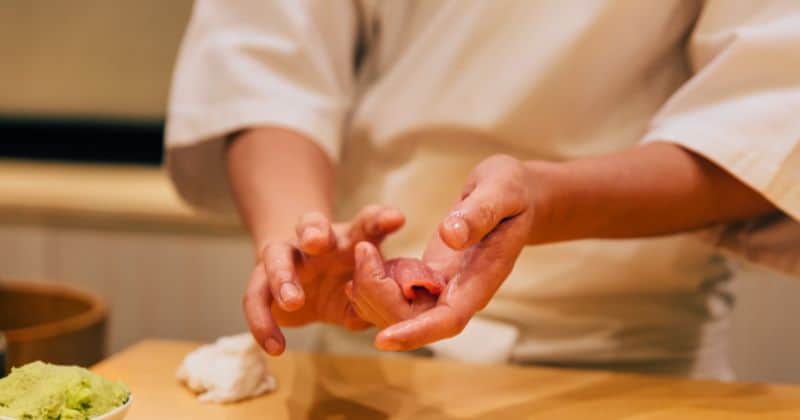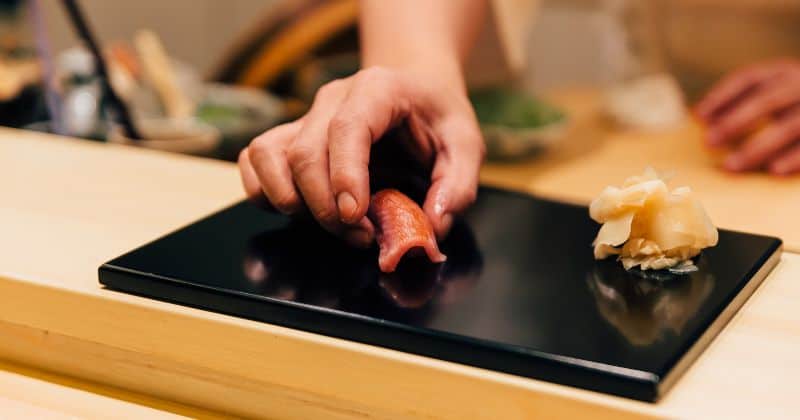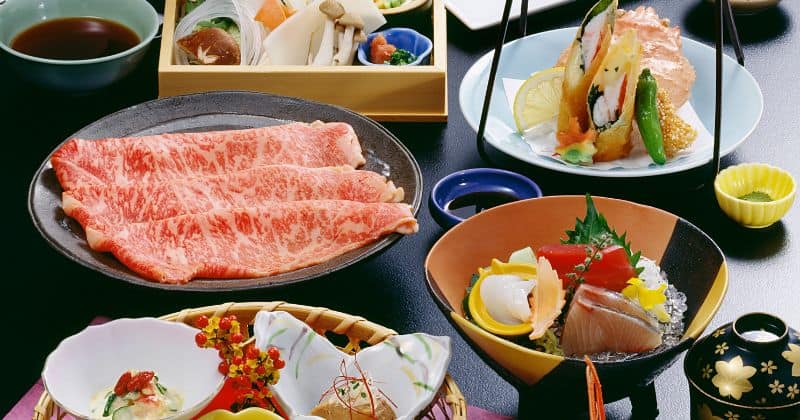There is something special about omakase. It’s the feeling that you’re getting something unique that you can’t get anywhere else. It’s the feeling of being in the know, of knowing that you’re getting something unique that few people experience.
And for those who are interested in omakase, it can be an incredibly expensive experience. The price for omakase can often be ten times or even more up to the cost of an everyday meal. But what is Omakase? And why is it so expensive?
What is Omakase?

Omakase お任せ means “I‘ll leave it to you” in Japanese. It’s a multi-course meal where you let the chef choose what to serve you, and it’s often seen as the pinnacle of sushi dining experiences. You can expect around 8 – 20 courses, depending on the restaurant.
Omakase is often seen as a luxurious experience and can be costly.
The price for omakase can range from $100 to $400 or even more per person; yes, its price excludes tax, drink, and gratuity. And for some people, that’s too expensive for a meal.
But some are willing to spend the money on omakase because they see it as an investment. They see it as an opportunity to try something new and different and have an experience they can’t get anywhere else. SO that is why many sushi lovers are happy to shell out the big bucks for omakase.
Why is Omakase so Expensive?
In short, Omakase didn’t always expensive. The traditional word stands for leaving it up to the chef. So there are a few reasons why omakase can be so expensive, including the quality of ingredients, skilled chef, the experience you will get, and the rarity of some served items.
First, the fish used in omakase is often of the highest quality. This means that it’s both rare and difficult to get. An expert chef with years of experience is needed to prepare the fish just the right way.
Whether you eat omakase in NYC, LA, or any country with omakase style – fresh fish will be imported directly from Japan and primarily from the Toyosu market (the new Tsukiji fish market). Some chefs also desire to use local fish; anyway, they will look only for premium quality fish for you. It’s like essential to guarantee the quality of each dish.
Second, the chef mostly comes from Japan. Even if they are not natively, they must spend years learning and mastering their craft. They often start as apprentices, working their way up through the ranks. This takes a lot of time and dedication to master Japanese food skills.
As a result, the chef has a lot of experience and knowledge about sushi. They know which fish are in season and how to prepare them just the right way. This means they can create unique and delicious dishes you won’t find anywhere else.
Third, you will enjoy seeing the sushi chef’s performance in making sushi in front of you. The experience is about eating sushi and watching the chef prepare it.
The chef will introduce each dish and give you tips on how to eat it; you’ll often see the chef deftly cut the fish, form it into perfect little balls, and then add just the right amount of rice. It’s an actual work of art, and it’s something that you’ll remember long after the meal is over.
And that is why you’ll need to make a reservation in a high-end sushi restaurant to get this experience because there are limited seatings.
Fourth, the different story behind the course or restaurant. In some restaurants, the chef might use a family recipe that has been passed down for generations. Edomae sushi is one example. It’s an old-fashioned style of sushi that dates back to the early 1800s.
The name came from the fish caught in Tokyo Bay and transported to Edo (the old name for Tokyo). The fish would be marinated in a vinegar mixture, which helped to preserve it. This style of sushi is sporadic, and it’s only found in a few restaurants.
This means the restaurant has a unique story to tell, which can add to the overall experience.
Finally, the atmosphere in an omakase restaurant is often more refined and intimate than in a regular restaurant. This means you’ll be able to enjoy your meal in a more relaxed and comfortable setting.
You’ll often find that the staff is very attentive and happy to answer any questions you have about the food or the wine. This attention to detail is one of the things that makes omakase so unique.
Is Omakase worth trying?

For those who never eat Japanese food before, it might be better to start with sushi at a more casual restaurant. But if you enjoy sushi and are looking for a truly unique and memorable experience, then omakase is worth trying.
Anyway, it doesn’t mean every omakase is pricy. There are still some affordable ones. You can get an omakase meal in some sushi restaurants for around $50.
Of course, this is still more expensive than a regular meal, but it’s a fraction of what you would pay in a high-end restaurant.
Remember that you’ll need to make a reservation well in advance, as these restaurants are often trendy.
Where to eat Omakase?
It didn’t limit to Japan and famous cities like NYC, Los Angeles, or San Francisco. If your city has some Japanese restaurants, there might be an Omakase menu.
Here are some city guides for omakase:
- Connecticut, USA
- Montreal, Canada
- Toronto, Canada
- Vancouver, Canada
- Sydney, Australia
- Kuala Lumpur, Malaysia
- Jakarta, Indonesia
We’ll update more city guides in the future.
What dishes can you expect in Omakase?
Omakase means that the chef will choose the dishes for you, so you can expect to be surprised by what you get. Sometimes people may use the word omakase and kaiseki interchangeably.

While kaiseki is a more formal style of Japanese cuisine, it often includes sushi as one of the courses. Kaiseki is more serving the entire dish, while omakase focuses more on sushi and small portions.
Some dishes are often served in omakase meals. These include:
Appetizer – This is often a light dish to open your taste bud.
Sashimi – This is a dish of thinly sliced raw fish. It is usually served with soy sauce and wasabi.
Nigiri – This is sushi, where the fish is placed on rice.
Maki – is a roll of sushi often made with cucumber, avocado, or salmon.
Tempura – This is a dish of fried vegetables or seafood. There also has Tempura omakase only served tempura.
Soup – A light soup is usually served at the beginning of an omakase meal.
Dessert – A simple dessert is generally done at the end of the meal. This might be a fruit or a small cup of green tea.
The dishes served will depend on the season and what is fresh. The chef will use their expertise to choose the best words for you.
You can expect to be served around 10-20 dishes in an omakase meal. This might seem like a lot, but you will eat small portions. However, it is still full because of the sushi rolls.
What things do you need to know before you try omakase?

There are some rules that you should know before you try omakase:
- Omakase needs reservations in advance.
- If you have allergic to some foods, let the restaurant know ahead of time.
- Be on time for your reservation. The chef will begin to serve when everyone at the table is ready.
- You should be prepared to eat raw fish. If you’re not a sushi fan, then omakase might not be for you.
- Drinks are not included in the price, so you must order them separately.
The best way to enjoy omakase is to go with an open mind and be ready to try something new. You should not cancel what you don’t like to eat.
The chef has put a lot of thought into the meal, and it is considered rude not to eat everything served.
If you are unsure about something, ask them before taking reservations so they can adjust the meal.
In Japan, Omakase didn’t limit to food.
It also applies to other services, such as haircuts, cocktails, travel tours, and even fashion. The meaning is still the same: leaving it to the professional to decide.
It’s like no spoil the fun; enjoy the moment and let the expert handle it.
For example, in a hair salon, you might ask for an omakase haircut, leaving it up to the stylist to decide what cut is best for you.
In a cocktail bar, you can ask for an omakase cocktail which means that the bartender will make a special drink for you based on your preferences.
And in a fashion store, you can ask for an omakase style which means that the salesperson will help you choose the perfect outfit.
Omakase is all about trusting the expert and allowing yourself to be surprised and delighted by the results.
So, if you’re ever in Japan (or any other country with a strong Japanese influence), try out this unique experience. You won’t be disappointed!
